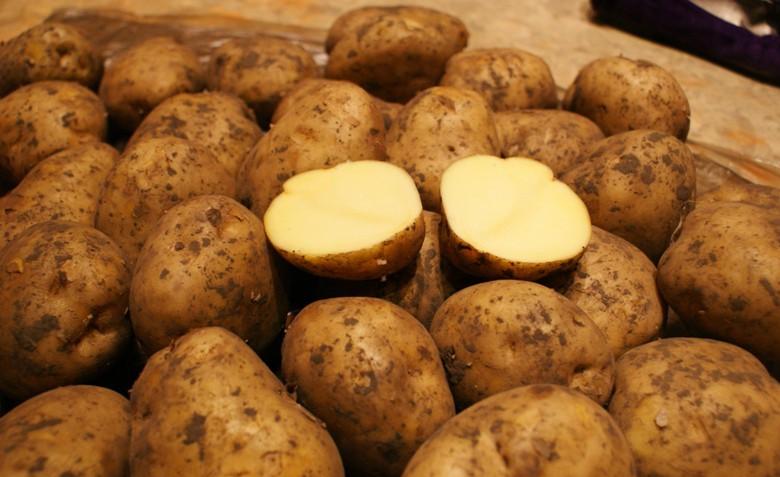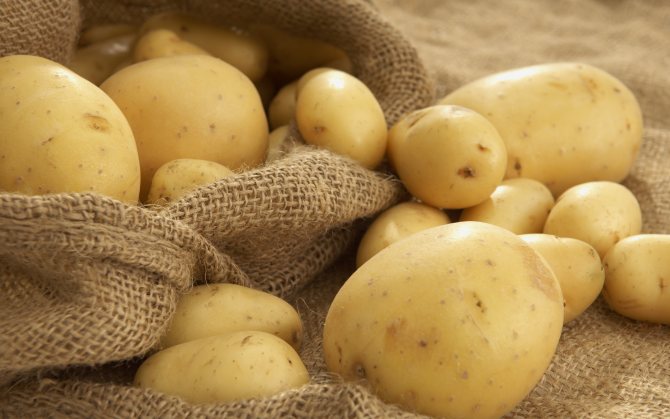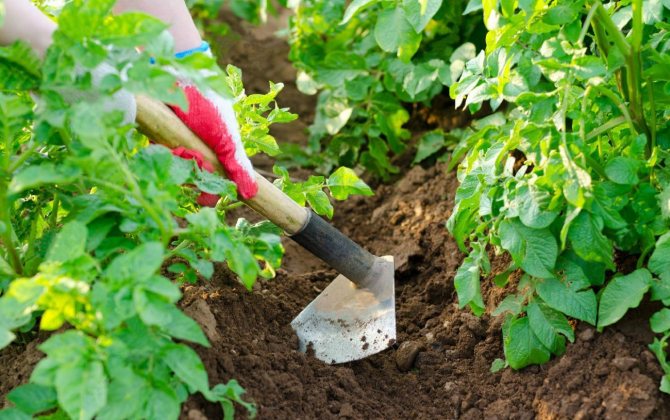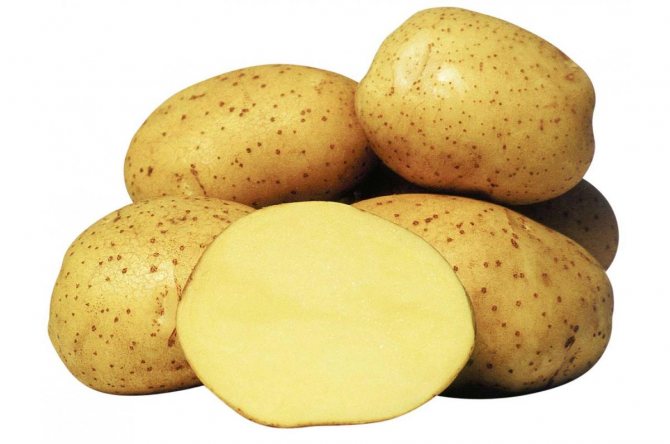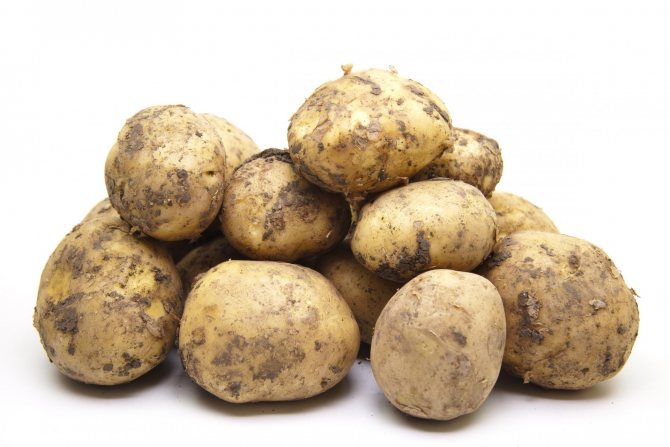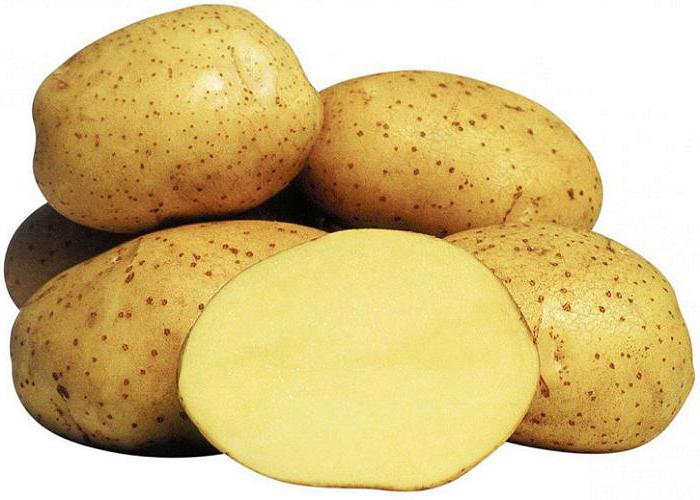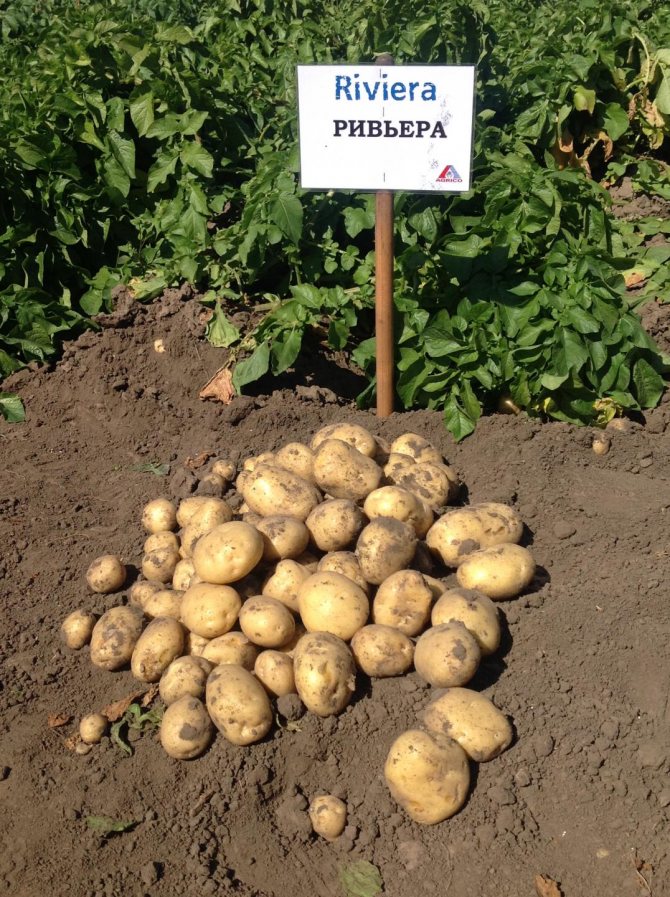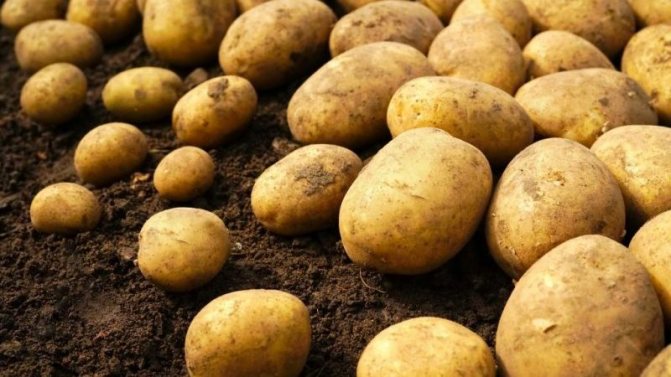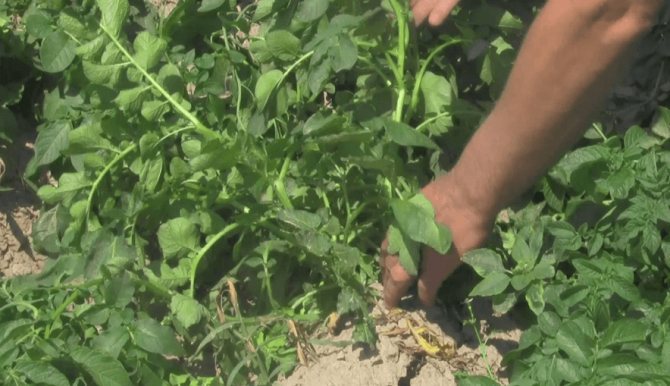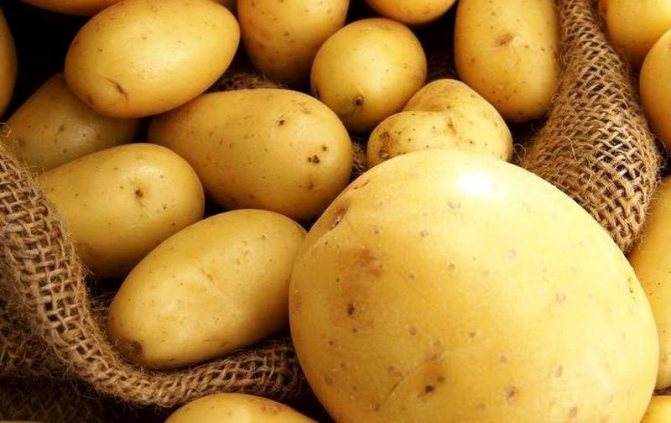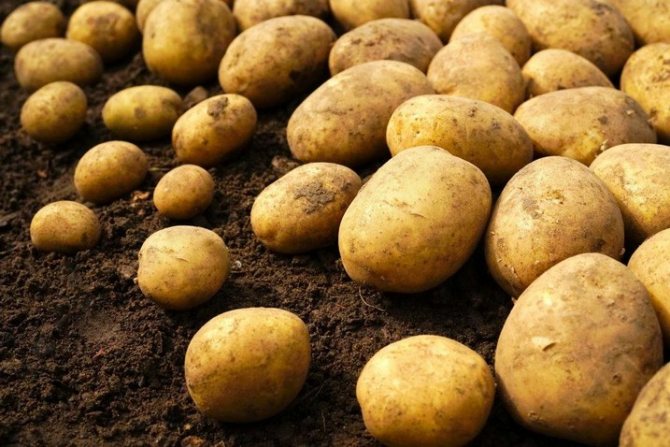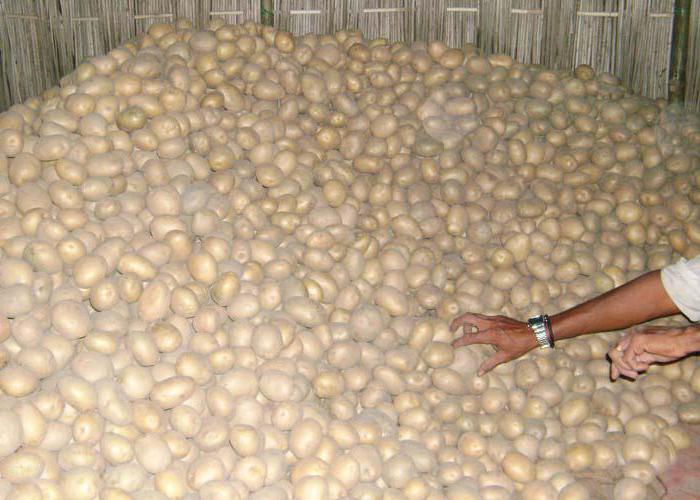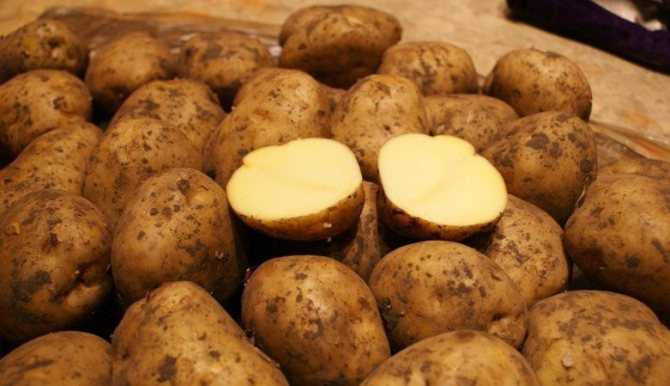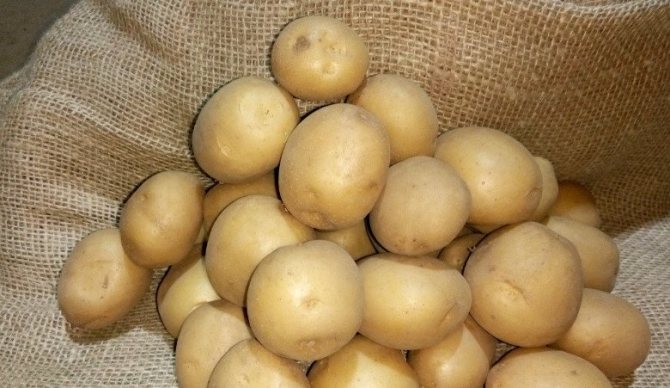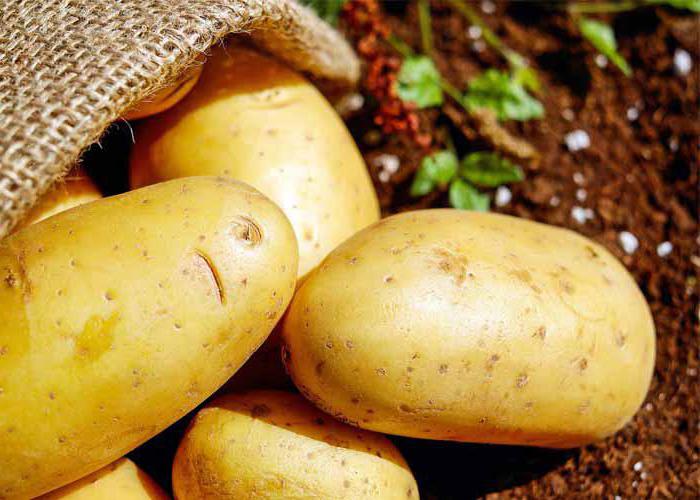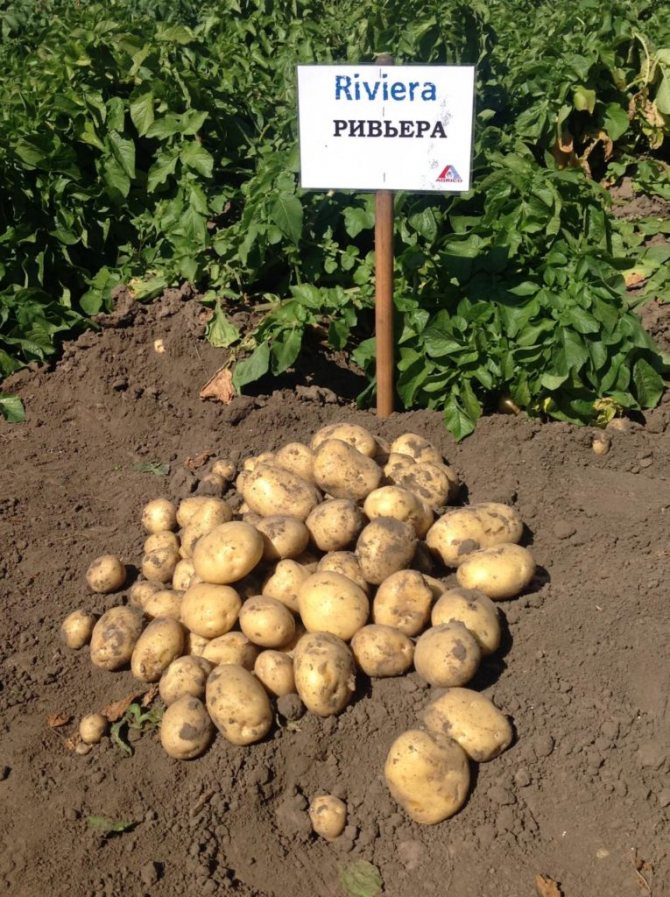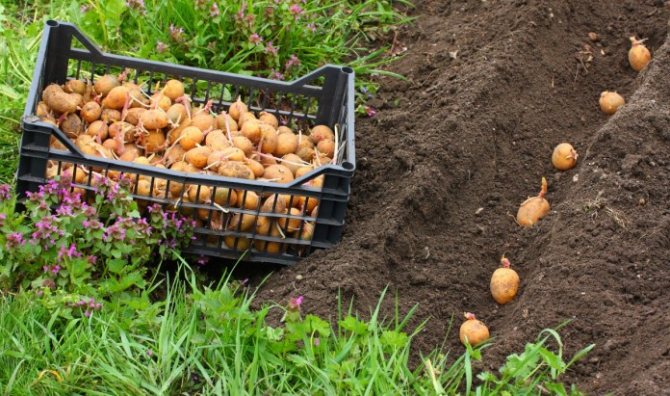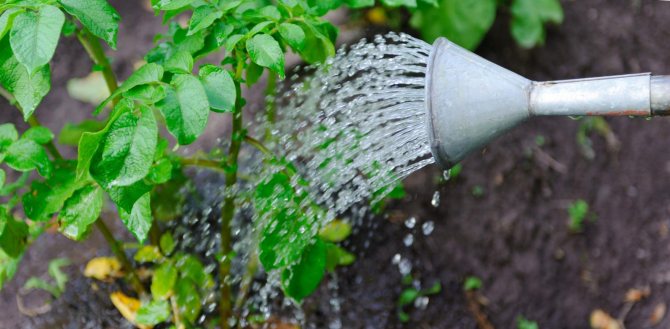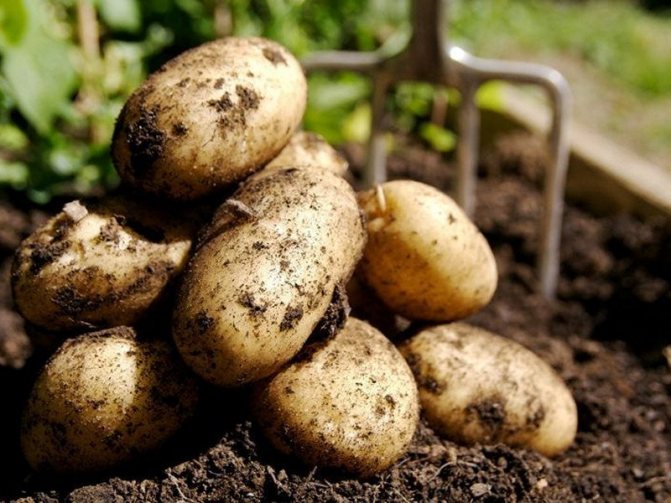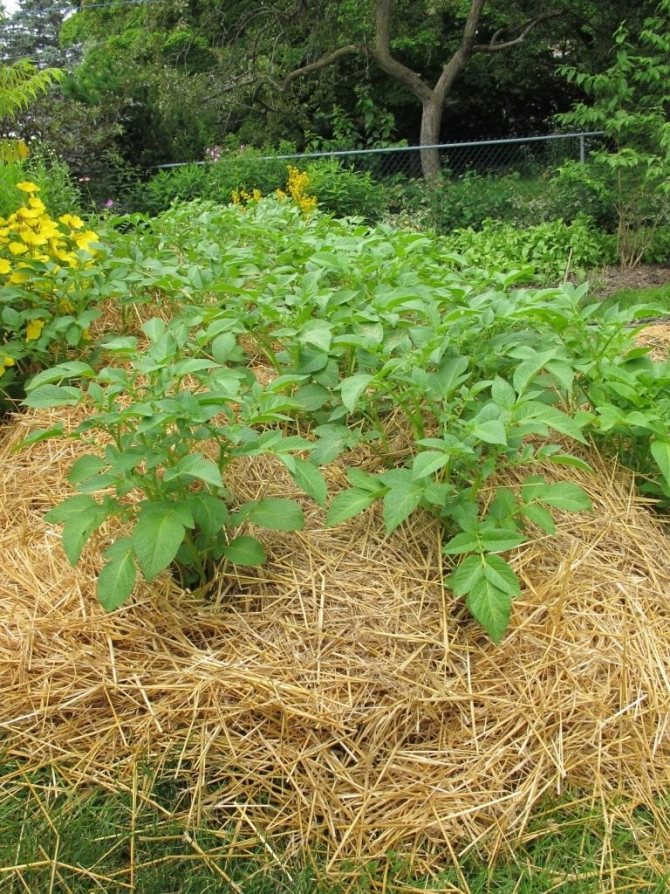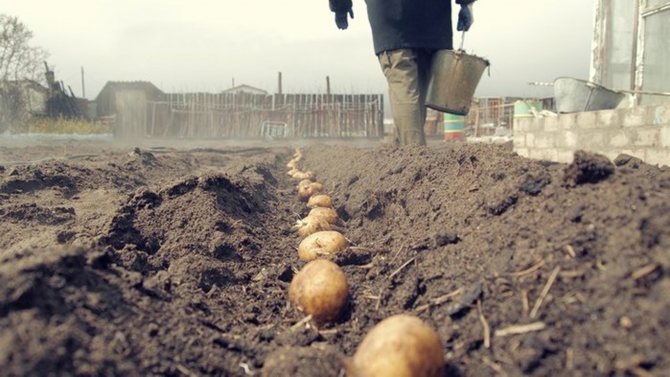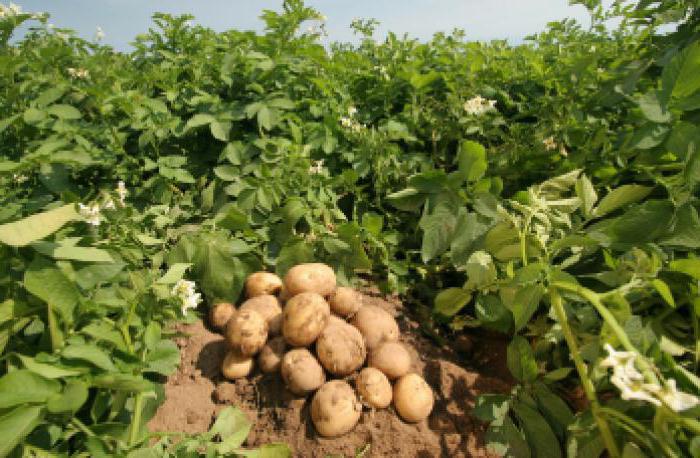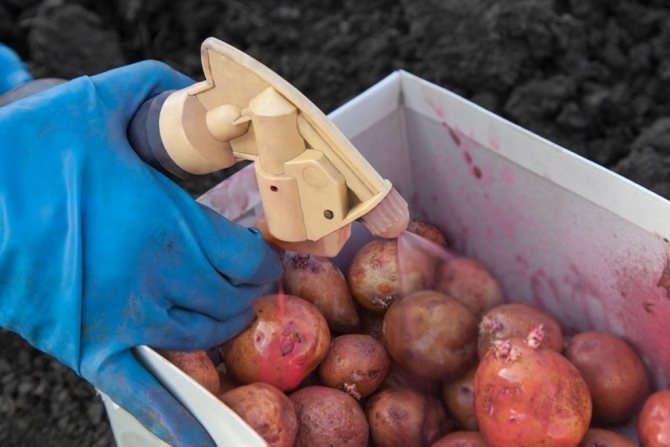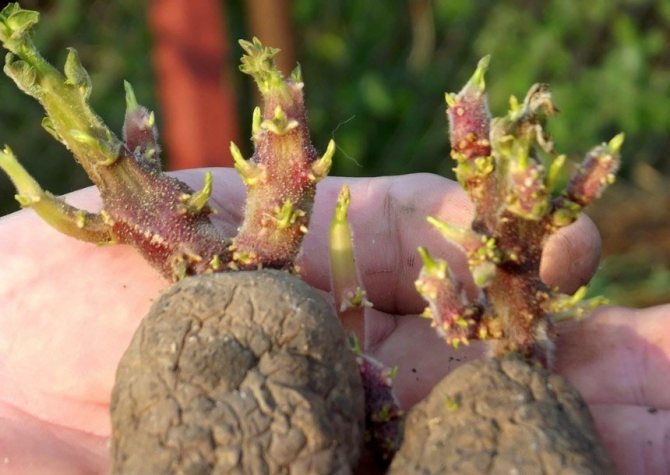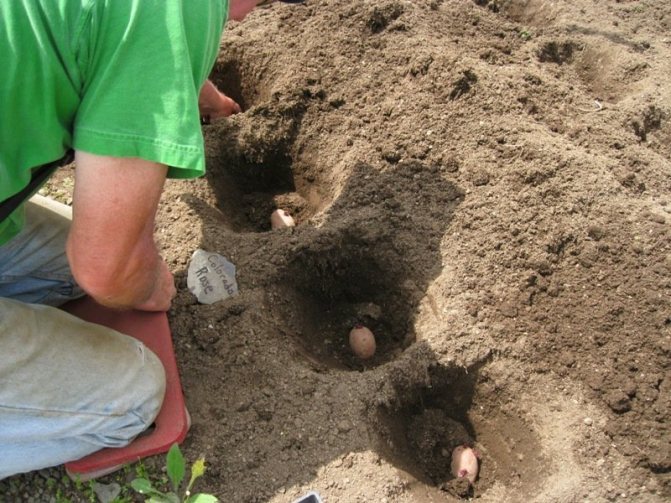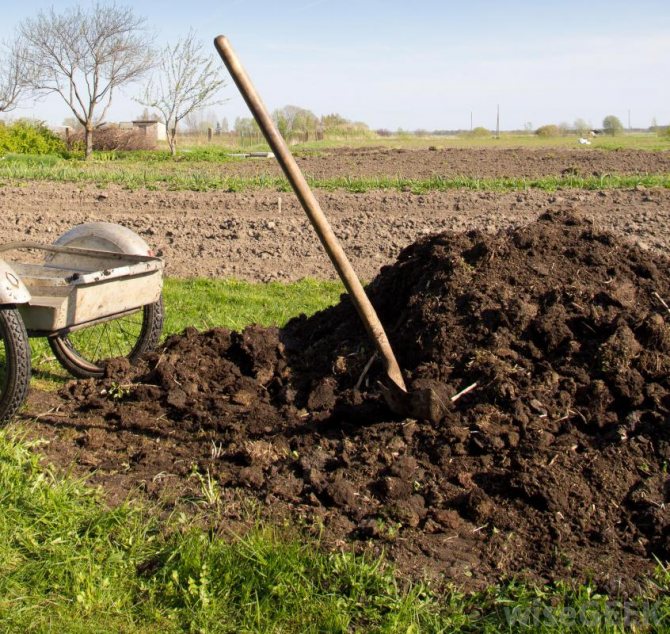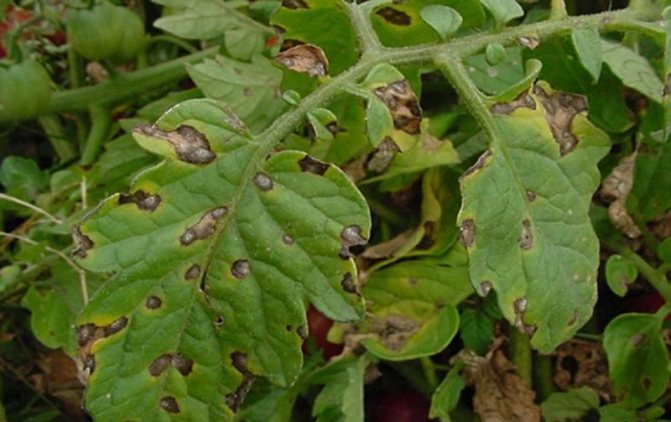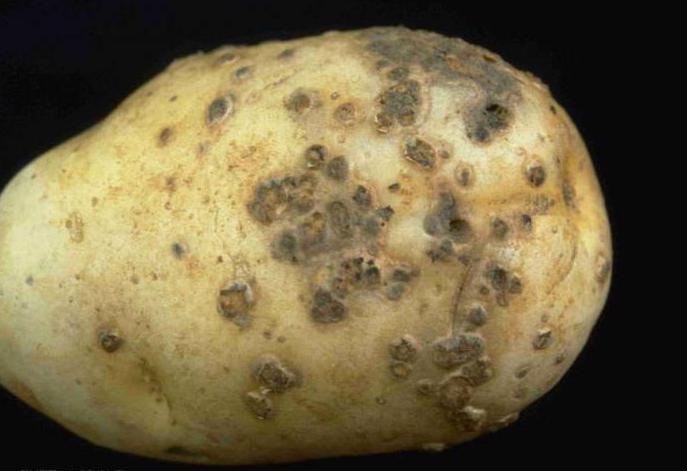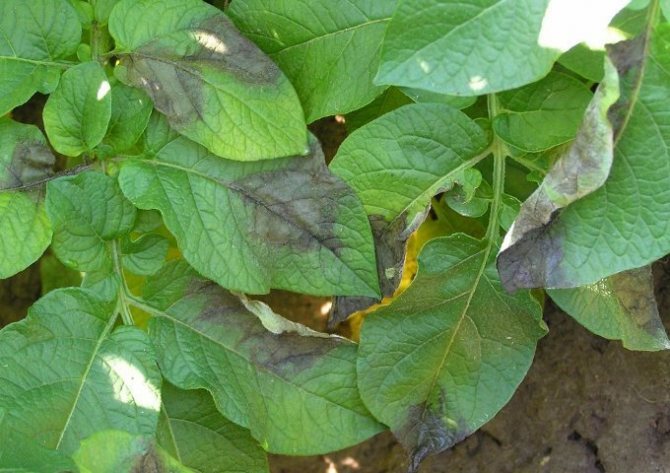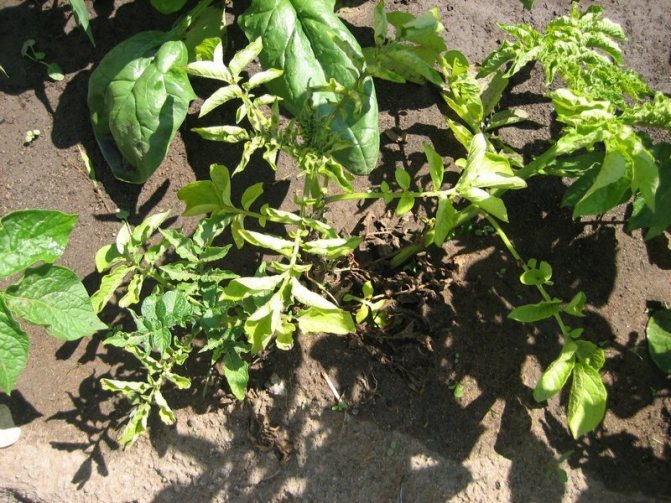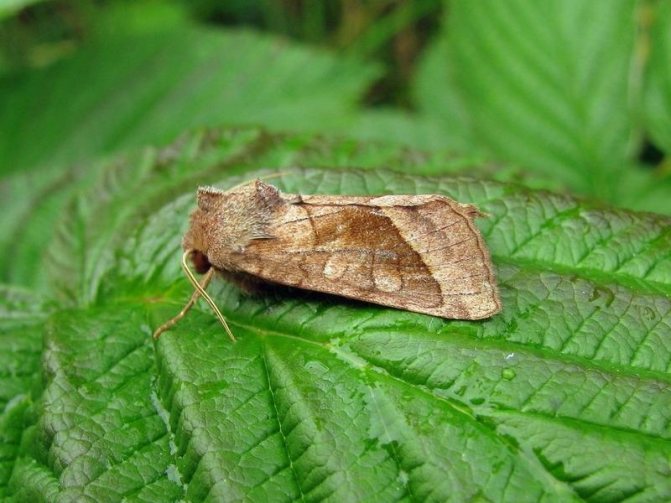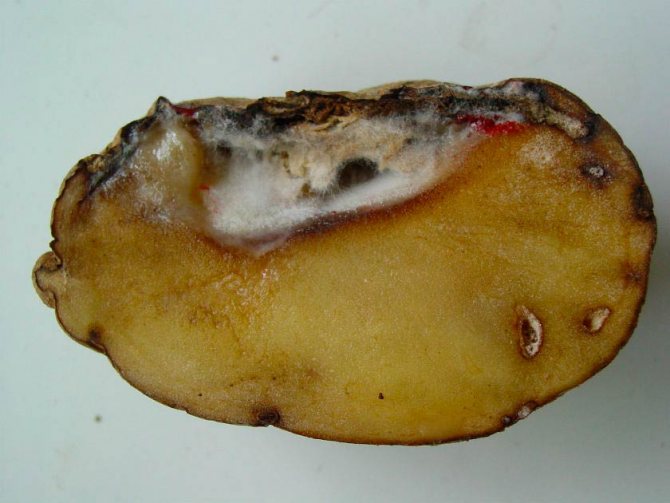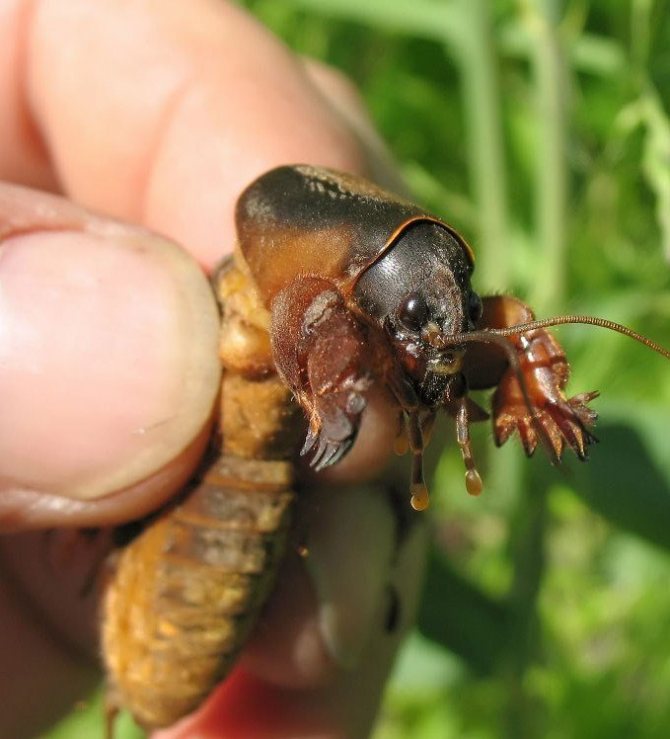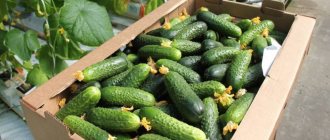“Potatoes are the second bread,” they said in Russia. And this is justified, no fast food can compare with young boiled potatoes, sprinkled with finely chopped herbs. And the sooner it appears in our gardens, the better, therefore varieties of early potatoes are always held in high esteem, and super early ones are worth their weight in gold. One of these varieties is the Riviera potato. Let's try to figure out what is the advantage of this variety over the others and how it can be inferior.
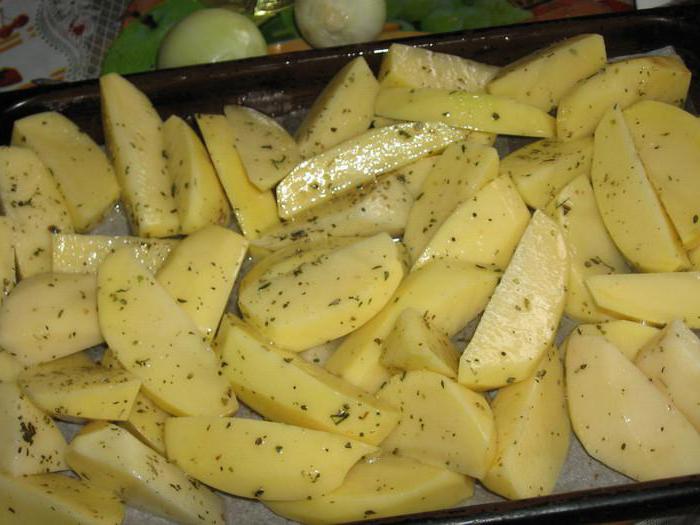
The history of the origin of the potato variety "Riviera"
The “Riviera” variety was obtained by crossing the Dutch varieties “Minerva” and “Alkmaria” by the specialists of the agricultural firm Agrico (Holland).
Included in the State Register of Russia in 2013.
The table shows data on the mass of marketable tubers (grams) of different varieties:
| Name | Variety | Weight |
| Nikulinsky | Late maturing | 70 to 120 |
| Cardinal | Late maturing | 65-110 |
| Rocco | Late maturing | 100-120 |
| Picasso | Late maturing | 80-140 |
| Borovichok | Early ripe | 120-200 |
| Elmundo | Early ripe | 120 |
| Felox | Early ripe | 100 to 120 |
| Bellarosa | Early ripe | 120 to 210 |
| Karatop | Superearly | 58 to 100 |
| Zhukovsky early | Superearly | 100 to 120 |
| Farmer | Superearly | 90 to 110 |
| Minerva | Superearly | 120 to 245 |
| Sorcerer | Mid late | 75 to 120 |
| Mozart | Mid late | 100 to 150 |
| Grenada | Mid late | 800 to 100 |
| Melody | Mid late | 95 to 180 |
| Giant | Mid-early | 100-140 |
| Tuscany | Mid-early | 90 to 125 |
| Purple Haze | Mid-early | 90 to 160 |
| Openwork | Mid-early | 90-120 |
Cultivation regions:
- North Caucasian;
- Central;
- Central Black Earth.
Potato varieties - Riviera Potatoes (Holland):
Varietal characteristics
Description of the bush
Bushes of the Riviera are medium in size, well leafy with semi-erect stems. The leaf plates are light green, well developed. The flowers of the Riviera are white. In the early stages of development, the variety is characterized by accelerated growth. The peculiarity of the Riviera is that it spreads the leaf on the ground, when many other varieties are still standing with straight stems until the end of the growing season.
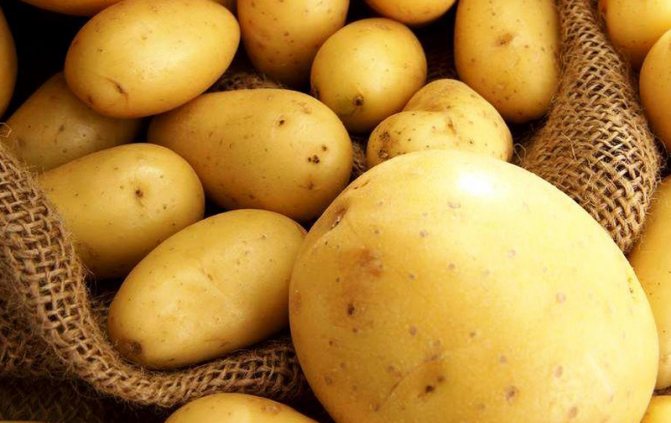

When grown in the south, two full harvests are possible. Young tubers can be dug in 45 days from planting; it takes about 80 days to fully ripen.
According to the characteristics and reviews, the tubers of the Riviera potato variety are oblong in shape with yellow pulp. The eyes are not deeply buried in the surface of the peel. The average number of tubers on a bush is about 10 pieces. Subject to agricultural technology, the mass of each tuber can reach 200 grams. In terms of its characteristics, the Riviera potato variety can be compared with the early Zhukovsky. Due to its good taste, this potato is great for frying, mashed potatoes, soups.
The advantages of the Riviera include:
- high resistance to viral diseases;
- excellent yield indicators;
- stress tolerance;
- excellent taste.
Among the disadvantages, it should be noted that it is highly susceptible to late blight.
Description of the variety
Roots:
- Smooth tubers have an oval-round or oval shape;
- The peel is light yellow, slightly rough;
- The pulp on the cut is light yellow or cream in color;
- The starch content is 19.6%.
Riviera potato yield on day 60:
Shoots:
- Tall bushes of intermediate type, erect;
- Corolla is red-violet;
- Leaves are large, dark green in color, with wavy edges;
- Strong stems;
- Powerful root system.
Yield of Riviera potatoes on the 60th day after planting:
Fruit pests - table
| Pests | Description | Control methods |
| Colorado beetle | An adult beetle looks like a ladybug, but with a different color - in a longitudinal black-yellow strip. The larvae are bright orange. On the same plant, you can see different stages of development: eggs, larvae of different sizes and beetles. In such a neglected state, the bush is destroyed by pests in a couple of days, only bare stems remain. Beetles hibernate in the ground. |
|
| Wireworm | Wireworms are the larvae of the Nutcracker beetle. The beetle has an elongated brown, gray or black body about 3 cm long, some species grow up to 6 cm. The worms are orange, tough, for which they got their name. Wireworms bite into potato tubers, feed on pulp, and make numerous moves in it. | |
| Medvedka | A large orthoptera insect 6 cm long was named for its brown color, clumsiness and claws on its front paws, similar to those of a bear. Other names: spinning top - for the gray color of the larvae, earth crayfish - for the presence of claws and cabbage - for addiction to cabbage. For wintering, the insect digs vertical shafts up to 120 cm deep. The pest can be found in holes 1–2 cm in diameter and in piles of earth nearby. In summer, in search of food, the bear makes horizontal passages at a depth of 3-5 cm and eats everything that comes in its way: tubers, stolons, roots, stems. |
|
| Beetle or beetle larvae | May beetles are large flying insects that live in tree crowns and fly into the light at night. Large harm to root crops and potatoes is caused by their larvae. These are light-colored worms 4–7 cm long with a brown head and legs in front of the body. The main feature is that the larvae are always curved in the shape of the letter "C". Pests eat the flesh of the potato along with the skin. The tubers look like apple cores. |
|
Photo gallery: the most dangerous pests of potatoes
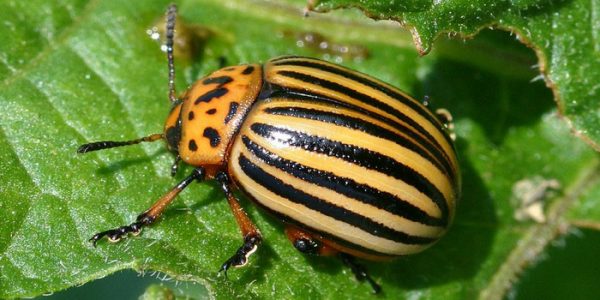

Colorado potato beetle with a body shape similar to a lady's crust
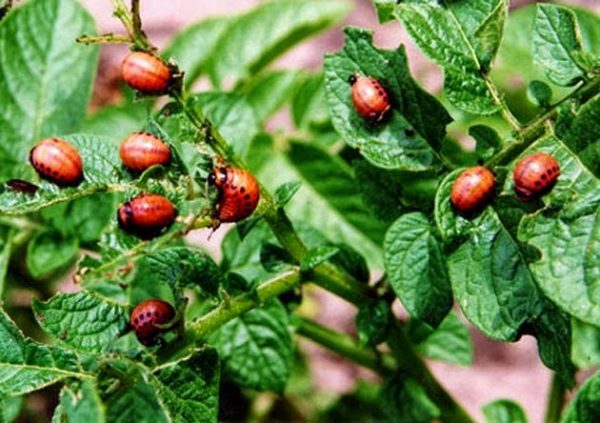

Colorado potato beetle larvae eat potato bush
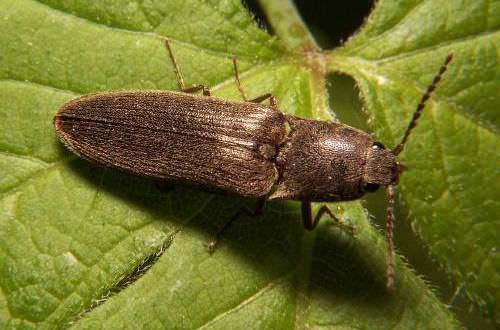

Often during weeding, you can see the Nutcracker running through the garden
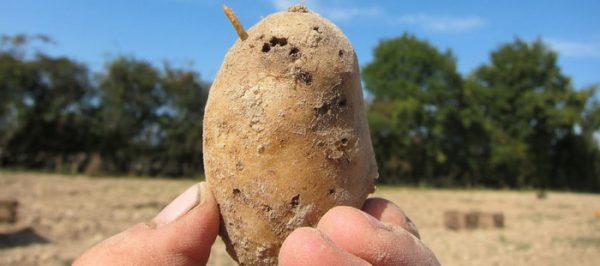

Potato Perforated by Wireworm, Nutcracker Maggot
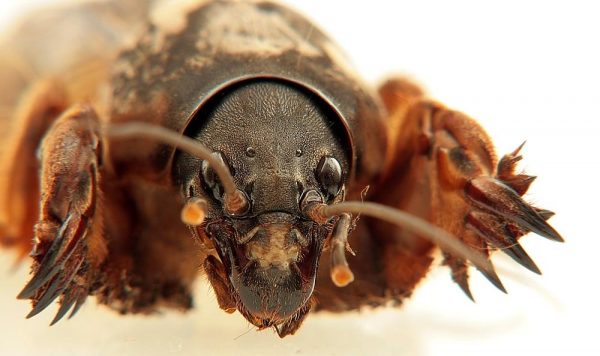

The bear is clumsy and brown like a bear
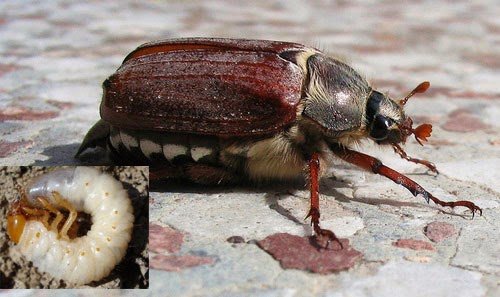

Khrushch and its larvae love soil fertilized with fresh manure
Advantages and disadvantages
It has the following advantages:
- Excellent taste;
- Good marketability of potato tubers (90%);
- Resistance to the causative agent of potato cancer, scab, potato nematode, viral infections;
- The keeping quality of tubers exceeding 93%;
- The yield from one bush can reach from 10 to 12 tubers.
REFERENCE: A relative disadvantage is the instability to late blight, therefore, preventive spraying is necessary.
Tuber preparation
Pre-planting preparation consists in germination of tubers. To do this, they are placed in a bright, warm place. The tubers are kept until strong, thick sprouts are formed. On average, germination takes about 25-30 days. The temperature during germination should not exceed 15 ° C. Higher values cause increased evaporation of moisture, leading to wilting of the tubers.
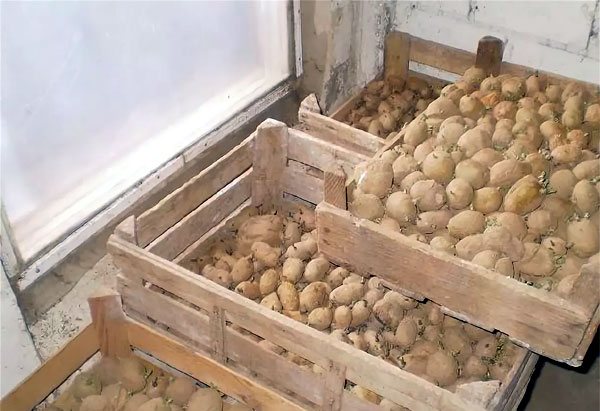

Immediately before planting, the tubers are powdered with wood ash. This technique contributes to friendly germination and an improvement in taste. Tubers grow more starchy, crumbly.
Advice! To increase productivity, 2 days before planting, you can use soaking in growth stimulants - succinic acid or heteroauxin.
Features of the
Characteristics:
- Riviera can be grown under film to obtain super-early production. In the southern regions, crops are harvested twice a season;
- The ripening period takes from 40 to 80 days. The yield after the first digging on the 45th day after the emergence of potato shoots is from 134 to 225 centners per hectare. The maximum yield by the end of the growing season reaches 450 centners per hectare;
- Resistant to mechanical damage during harvesting: from 80 to 96% of tubers retain their presentation;
- Unpretentious to care for, the harvest does not depend on weather conditions.
Growing early potatoes, Riviera variety:
Harvesting and storage
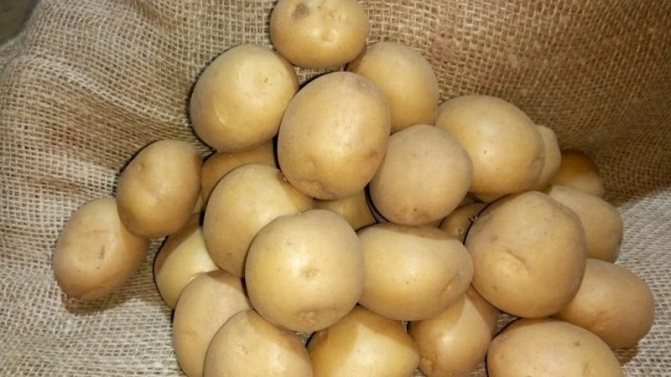

Harvested in late June - early July, the second time - in September. The potatoes are sorted, the seed is laid out in a sunny place for greening.
The dug up tubers are dried in a boundary or under a canopy. They sort out, throw away rotten and diseased potatoes. Healthy tubers are put in containers, taken to storage in a dry basement.
Storage features and keeping quality
The walls of the basement, where the potatoes will be stored, and the tubers themselves are sprayed with "Antignya". This increases keeping quality. The cellar is whitewashed from the inside with lime. The tubers are treated with a solution of copper sulfate - 0.1 g per 8 liters of water. Temperature range - + 2… + 4 ° C. During the winter, potatoes are sorted 2-3 times.
Store root vegetables in:
- basements, in bulk;
- wooden lattice boxes;
- containers with holes;
- bags, nets.
The tubers are covered with spruce branches, bitter wormwood. This prevents the fruit from rotting. Precautions will allow you to keep 94% of the crop without loss until spring.
What can be the difficulties in growing
Gardeners are faced with late blight and other diseases, an invasion of insect pests. Failure to comply with agrotechnical rules will lead to diseases of the tubers. All of these factors affect their shape, size, structure and reduce productivity.
Correct fit
Basic landing rules:
- For growing potatoes, light and well-processed loams or sandy loam soil are suitable. Heavy and stony soil slows down growth and deforms tubers;
- The soil must be thoroughly cleaned of weeds, and also fertilized with high quality;
- Give preference to planting material weighing 80 grams. For two weeks before planting, leave the potatoes for germination in a room with a temperature of +12 to + 15 ° C. Planting sprouted tubers promotes the emergence of seedlings after 8-14 days, and accelerates the ripening of the crop a week earlier;
- Observe the crop rotation: change the landing site every three to four years;
- Planting is carried out in May, but the timing may vary slightly. Planting material is planted in the soil warmed up to + 10 ° C;
- When planting, use the standard scheme for early potatoes 60 x 35 cm, deepening the tubers from 8 to 10 cm.
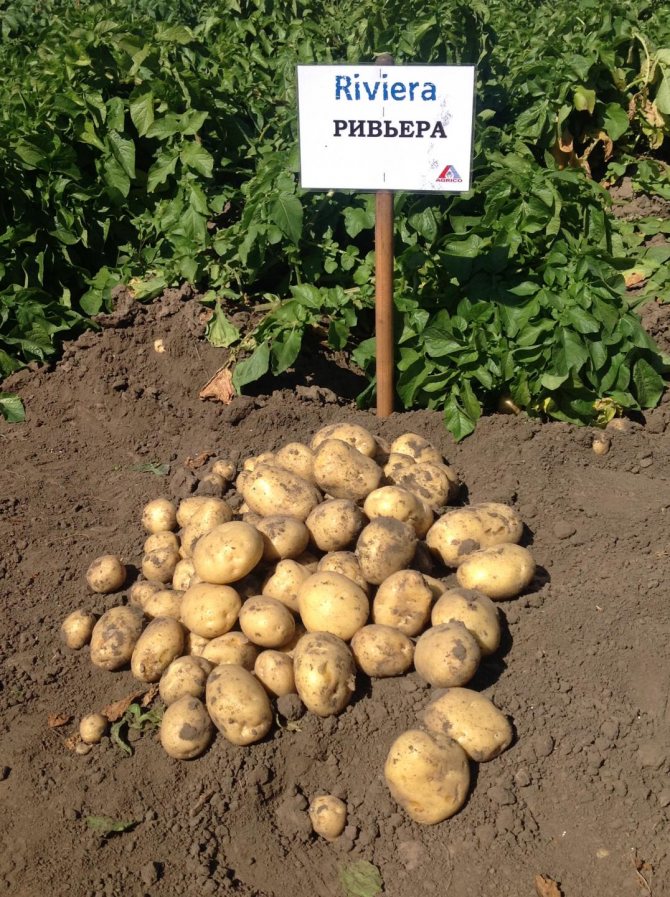

Growing the Riviera from seed
Growing potatoes from seeds is a rather troublesome business, but many vegetable growers decide on such experiments. Pros of seed growing:
- Potato seeds are several times cheaper than tubers.
- Potato seeds do not need a cool cellar for storage, they take up very little space and remain viable for 6-10 years.
- Potatoes grown from seeds are highly resistant to adverse conditions and resistance to various diseases.
- The yield of tubers grown from seeds is higher than that of those planted in the traditional way.
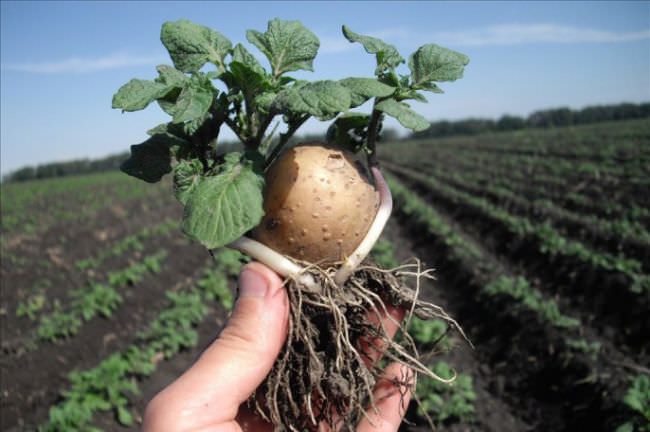

Some growers decide to grow potatoes from seeds.
Growing instructions
Sowing potato seeds should be done in late February - early March. Like seedlings of other plants, the culture is grown on a light windowsill.
The soil must be loose and fertile (ideally, you should purchase a special ready-made mixture). It is necessary to add the preparation Trichodermin to the ground (1 g per 1 l) or shed the soil with Fitosporin a couple of days before sowing - this is done in order to prevent damage to the seedlings by the "black leg".
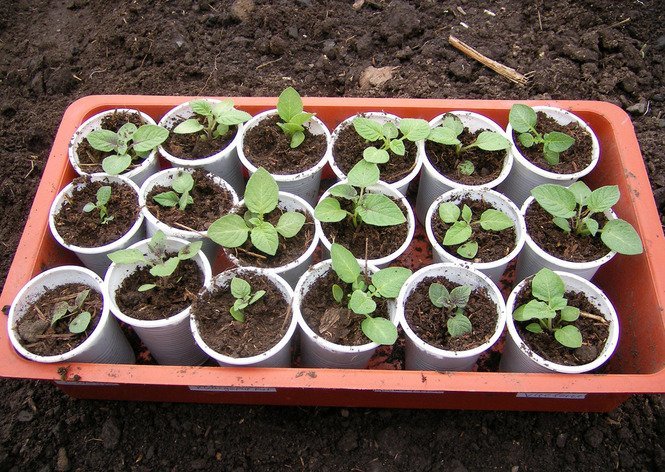

After warm weather settles outside, the seedlings of the Riviera are transferred to the balcony
Procedure:
- The potato seeds should be germinated on a damp cloth in a plastic container (there should be ventilation holes in the lid to prevent the seeds from becoming moldy).
- After the sprouts appear (usually on the 5-7th day), the seeds are carefully laid out on the surface of the previously moistened and compacted soil and sprinkled with a centimeter layer of sand.
- The future seedlings are carefully sprayed from a spray bottle, covered with cling film on top and placed on a well-lit windowsill (east or southeast).
- Approximately 25 days after planting, the potatoes are dived in a container with a volume of at least 0.5 liters, deepening it to the cotyledon leaves.
- When the weather outside becomes stably warm, the seedlings are transferred to a balcony or loggia.
- In the first year, potatoes should be planted in a greenhouse or greenhouse, and in the second year, they should be transferred to open ground. If you do not have this opportunity, you can plant the seedlings directly into the ground. This is done not earlier than mid-May, when the soil is completely warmed up and the threat of frost has passed. They always plant in cloudy weather or in the evening - this will make it easier for plants to adapt to a new place. Seedlings are planted at a distance of 40 cm from each other, in holes previously spilled with water and fertilized with a mixture of ash and humus. The stems are placed horizontally, sprinkling the plants with earth so that only the tops remain on the surface - this will help the formation of additional roots.
- After planting, the potatoes are mulched with ripe leaves or straw and covered with some covering material on top, which is harvested no earlier than June.
Further care of the plants is standard: it is necessary to water, mulch or huddle and apply top dressing in a timely manner. 2-3 weeks after planting, add mullein or grass infusion with ash to the soil, and fertilize the plants with potassium sulfate before flowering. When the tops turn yellow, the tubers must be dug up and stored as planting material for next year.
Care
The Riviera variety is an unpretentious variety, but providing good and competent care increases the yield and quality of potatoes. How to care:
- Harrow potato plantings twice along the rows until mass shoots appear, and twice after shoots appear;
- The first time the potato tops are hilled with a hoe when the stems reach a height of 14-17 cm, the second time - two to three weeks after the first hilling;
REFERENCE: When applying nitrogen fertilizers at a later date, the growth of green mass significantly increases, having a negative impact on the quality and quantity of the crop.
- Potato plantings are weeded well and regularly, and then the soil is loosened;
- If the leaves wither on the potato tops, and the soil is dry at a depth of five centimeters, then it is necessary to water the plantings;
- Abundant precipitation and sufficient soil moisture, together with the use of dry dressings (bird droppings), mineral fertilizers and ash, embedded in the soil during hilling, gives a good harvest.
Tasting Riviera potatoes:
Agrotechnics and rules for growing varieties
In order to shorten the growing season without losing the quality and quantity of yield, when growing the Riviera variety, you will need to perform certain agricultural techniques. In fact, it is not as difficult as it might seem at first glance. To complete it, it will be enough to follow the sequence below.
We recommend to read: Russian stove with your own hands with drawings and order
Selection and storage of planting material
As the reviews of gardeners have shown, it is better to select planting material immediately after harvesting. For this, healthy, undamaged fruits weighing from 40 to 70 g are selected from all tubers.
Read also: How to feed potatoes after planting
Important: Many novice gardeners believe that the greater the weight of the planting material, the higher the yield at exit. In fact, this opinion is erroneous. In one bush from a large potato, 2 times fewer fruits are formed than from an average tuber.
Having collected selected planting material, he is given time for 2 weeks to lie down in a well-ventilated and well-lit place. In this case, the skin of the potato will harden well before storage, and minor scratches will heal. Further, the tubers are moved to the cellar until spring. The optimum temperature for storing planting material is considered to be + 2–4 degrees, air humidity - 70%.
Tuber preparation
1.5 months before the proposed planting, potato tubers are taken out of the cellar. Planting material gets over from rotten and damaged fruits. Then the selected potatoes undergo sprouting and pickling.
Tuber germination methods:
- Light germination. This method is considered the most common. When using it, it will be enough to spread the tubers in a well-lit place and maintain an optimal temperature of 20 degrees. At the same time, it is recommended to periodically turn the potatoes over the course of a month, creating uniform illumination for them.
- Mini greenhouse germination. For this method, plastic bags are used, in which holes of up to 10 pieces are made. Then up to 10 potato tubers are placed in them. Seed bags are tied and hung from the ceiling of a bright room. In this case, you need to choose a place so that direct sunlight does not fall on it.
When sprouts appear on the tubers, and they are ready for planting, it is recommended to pickle them against various diseases. To do this, first, the potatoes are sprayed with water, and after a day they are treated with a disinfecting solution consisting of water, formalin and vitriol.
Site preparation for planting
The highest rates of the Riviera crop were recorded when potatoes were grown in fertile, light soil. It is desirable that the area with such soil be well lit from all sides and protected from the north wind.
Before planting, it is recommended to dig the selected area well, while removing all weeds and their rhizomes. It is advisable to add organic matter to the prepared soil. Rotted manure is considered the best fertilizer.
Tuber planting rules
When the regular air temperature reaches 20 degrees, and the soil at a depth of 10 cm warms up to 10-15 degrees, you can start planting tubers. Today there are several methods of planting potatoes. Reviews of gardeners indicate that it is rational to use the traditional method. This is justified by the fact that it is simpler and does not take up a lot of free time, which is so convenient if the dacha is located far from home.
Description of planting Riviera potatoes:
- In the area from north to south, ridges are formed, with a consistent distance from each other of 70 cm.
- Every 30 cm, holes are dug on the ridges, about 10 cm deep.
- One handful of ash is added to each pit.
- One potato tuber is placed in the hole and covered with soil.
After planting, the soil in the beds must be leveled with a rake.
Diseases and pests
The short growing season almost does not allow potatoes to be exposed to diseases. The "Riviera" variety is resistant to the causative agent of potato cancer, golden cyst nematode, banded mosaic.
Susceptible to late blight, common scab.
We suggest you familiarize yourself with potato varieties with different ripening periods:
| Late ripening | Early ripe | Superearly | Mid late | Medium early |
| Nikulinsky | Borovichok | Forty days | Crane | Yanka |
| Cardinal | Elmundo | Karatop | Sorcerer | Giant |
| Rocco | Felox | Riviera | Mozart | Tuscany |
| Kiwi | Bellarosa | Zhukovsky early | Grenada | Purple Haze |
| Ivan da Marya | Natasha | Farmer | Melody | Openwork |
| Picasso | Ariel | Minerva | Margarita | Santana |
| Asterix | Queen anne | Veneta | Ramona | Desiree |
| Slav | Arosa | Kiranda | Dolphin | Lady Claire |
Taste qualities
Riviera potatoes are the best option for lovers of young aromatic root crops. Analyzing the responses of experienced gardeners, it can be argued that this is a unique and almost ideal potato that can grow in any climatic conditions. Read about the advantages of the variety, as well as the competent cultivation technique in our article.
ShowHide
Riviera potatoes are a Dutch invention. The species was bred in 2007 by the Agrico holding (Netherlands). The bush is high (75–85 cm), semi-erect. The roots of the plant are quite powerful. The stem is dense, the foliage is dark green. Potatoes are oval or round, weighing 70–130 g. The peel is thick, rough, light yellow in color. The inside of the vegetable has a cream or straw color. The mass of the marketable tuber is 100–180 g. Agronomists note the high and stable yield of the variety.
One bush gives 5-9 tubers, but their number can reach up to 10-12 copies. The Riviera is a very early culture. You can cook your favorite dishes from young root crops already 40–45 days after the shoots appear. Potatoes fully ripen after 55-60 days. The maximum yield is 465 c / ha.
Farmers, whose plots are located in southern areas, can get two harvests due to the early ripening of the species. For the same reason, potatoes rarely bloom: the bush simply does not have time to bloom. But this in no way affects the quality of the crop. After digging up to 80–95% of tubers retain their commercial qualities.
Did you know? Germany's Linda Thomsen broke the record for the fastest peeling potatoes. The woman was able to process 10.49 kg of this vegetable in just 10 minutes.
Potatoes are universal in use - various first courses, casseroles, salads, potato pancakes, dumplings are prepared from tubers, and they are fried. The rind of the root vegetable does not crack when boiling or baking in the oven. The pulp of the potato crumbles after heat treatment. Chips and starch are produced commercially from the Riviera. Due to the high concentration of starch (12–19.6%), the root vegetable is very good as a puree.
- The Riviera potato is very promising - it stands out favorably among the early-ripening species with the following advantages:
- excellent taste;
- early ripening;
- high productivity;
- the opportunity to get two harvests per season;
- unpretentiousness in relation to climatic conditions;
- excellent presentation;
- high keeping quality;
- good resistance to diseases often affecting potato crops.
The disadvantages of the variety relate to the nuances of growing potatoes. The plant can be damaged by late blight. In addition, an attack by the Colorado potato beetle, bear and wireworm is not excluded.
Taking into account all the features of the presented variety, you can choose the optimal conditions for its cultivation and understand how much it is suitable for your site.
Table potatoes with good taste: on a 5-point scale, the variety is rated at 4.8 points. According to consumer reviews, the taste is higher in tubers dug out at the beginning of ripening. The tubers are used for a variety of salads, mashed potatoes, soups, and frying. The variety does not boil too much, since there is a little starch in it, the proportion of dry matter is 18.7%.
Variety reviews
According to gardeners, potatoes dug out in the early stages of ripening have the best taste. Mashed potatoes, salads, soups are prepared from this variety, as well as fried. The tubers have an average boiling point.
Riviera potatoes are a favorite of most gardeners and farmers. The main difference from other varieties is fast ripening and excellent taste, as well as unpretentious to the quality of the soil, resistant to dry periods. Properly prepared material and taking preventive measures against pests guarantees an excellent potato yield.
Early ripening potatoes of the Riviera variety, Chernihiv:
Planting tubers and caring for potatoes
Riviera thrives best in the open sun and loves loose nutrient grounds. The ideal soil is light sandy loam, moderately moist, breathable. It is not necessary to grow potatoes in the same place from year to year, since the fertility of the land decreases without crop rotation. Alternate planting potatoes with other fruit plants or green manures.
On heavy clay soils, you run the risk of a very small, ugly and tasteless crop. Sandy, excessively peaty, excessively moist soils, poor in calcium and magnesium, will certainly affect the yield, shape and size of fruits.
In summer cottages, potatoes are often the first crop planted on freshly dug virgin soil, and for good reason: after just one season of potato cultivation, the soil becomes loose, fertilized and is perfect for further planting of other vegetable plants.
Preparation of planting material and site
Seed selection is best done in autumn, when the potatoes are harvested. Sift small tubers right away and place them in a separate drawer or storage bag.
Before planting seed potatoes, it is recommended to germinate 0.5–2 cm until shoots appear. This will allow the potatoes to root faster and sprout for green tops and rhizomes for early tuber formation.
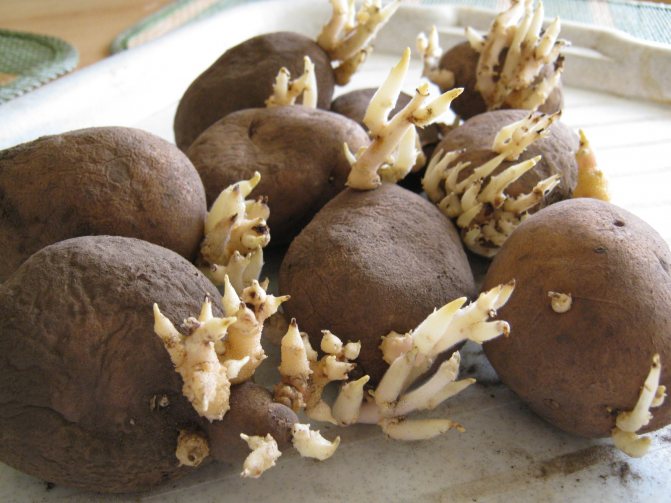

Sprouted potato tubers, ready for planting
At the end of winter, take out seed potatoes and test them. Remove the shoots that have appeared in the dark, sort out all the tubers. A month and a half before the planting season, spread the seed potatoes in one layer and place in a bright place for germination. The optimum temperature is 10-15 degrees.In the sun, planting potatoes are warmed up for two to three weeks before greening.
From the sprouts that appeared during the winter, while the potatoes were in the cellar or basement, seedlings can be grown. Agricultural technology is not difficult. The sprouts break off from the tuber, planted in a glass or other container. While the bush is growing, small nodules are poured into its root, which next time will be the seed material.
You need to plant potatoes only in warm ground. Planting the Riviera variety in April, provided that the ground has already warmed up enough, will give a good harvest by the end of May. Different regions have different planting dates. There is no point in rushing. Potatoes will still not germinate until the ground warms up to the planting depth (6-10 cm). Landing is carried out in damp ground. The Riviera produces very strong and long rhizomes. It is believed that the best seed potatoes are tubers the size of a chicken egg, weighing 30-60 grams, preferably no more.
Time and scheme of planting potatoes
Most often, potatoes begin to be planted in early May, in the southern regions - in April. According to popular belief, it's time to plant potatoes - this is the blooming of leaves on a birch to the size of a five-ruble coin.
The tubers are planted at a distance of 35–40 cm between the holes, between the rows - 65–70 cm. Use a string to mark the rows.
Planting potatoes - step by step guide
- Before planting, the soil must be dug up or plowed. Dolomite flour or lime must be added to acidic soil. The earth should warm up to a temperature of 10-15 degrees.
- Mark the rows for planting potatoes using laces with a gap of 70 cm between them.
- In the created holes or furrows, you can add a handful or two of humus or manure and add a little wood ash.
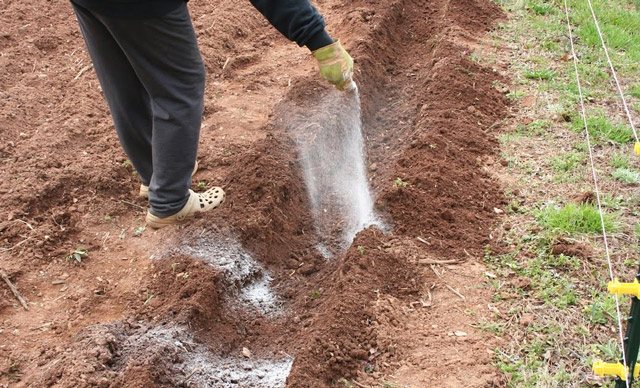

Ash is an excellent fertilizer for many crops, including potatoes. - Lay out the potatoes, growths up, in 35–40 cm increments.
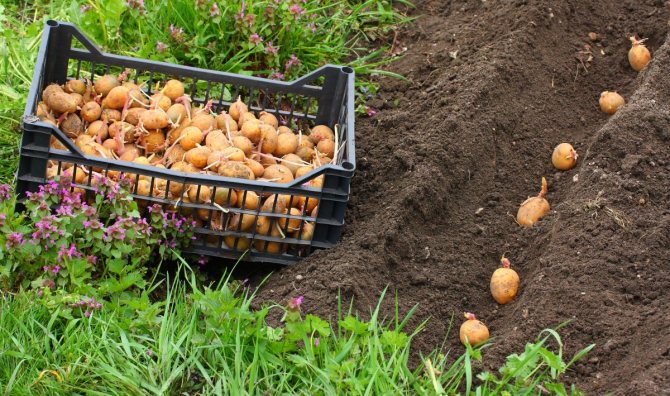

Potatoes are planted at a distance of 35 cm from each other to form rhizomes with tubers - Cover with soil so that the tubers are at a depth of 6-10 cm.
How to germinate and plant potatoes correctly - video
Potato agricultural technology
The Riviera variety does not need abundant watering, with the exception of particularly dry periods. In the eastern and northeastern zones of risky farming in Russia, it is imperative to monitor the weather. If it rains heavily, it would be nice to feed the soil with dry mineral fertilizers. If there is a drought, it is worth digging in the potatoes in order to control and suppress the massive spread of late blight on the tubers.
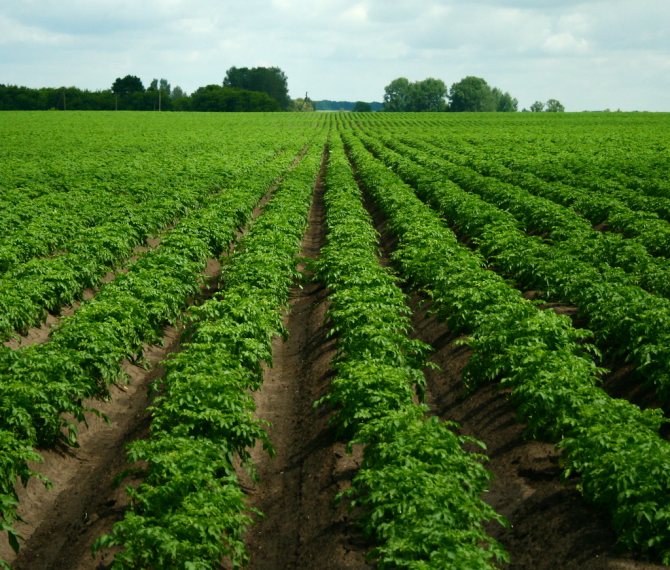

Industrial cultivation of Riviera potatoes
Potatoes love loamy, peaty and sandy loamy soils, rich in nitrogen and potassium. In villages and villages, feeding with humus and rotted manure directly into the holes is very common. On large fields, farmers use fertilizers in liquid form: a solution of chicken manure or slurry.
A mandatory procedure in potato farming is loosening... In most cases, gardeners huddle potatoes so that the basal stems do not bare, do not hurt, and tubers sprouting in the ground are better filled, saturated with oxygen. For the same purpose, it is necessary to remove weeds on the site in a timely manner. Potato roots use much more oxygen during growth and loading than other crops.
Hilling potatoes is carried out twice a season. The first one - with a leaf height of 14-16 cm, the second - after two to three weeks, before flowering. A hoe or flat cutter is used as tools, but you can also do this using a cultivator, walk-behind tractor or other equipment.
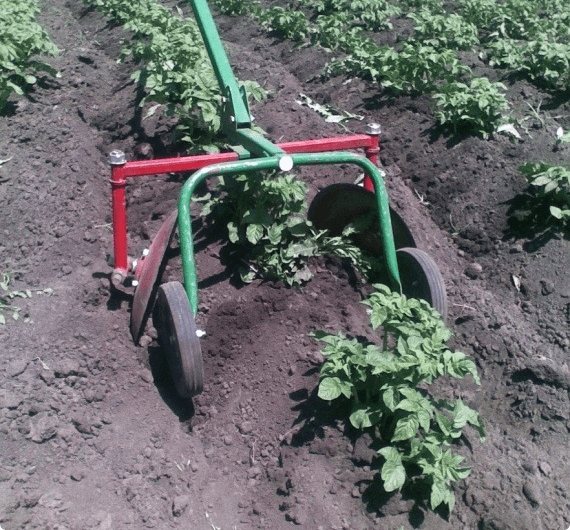

Hilling potatoes in classic cultivation is carried out twice a season
Seedlings of sprouted potatoes will appear in 8-12 days. When planting unprepared seed material, you will have to wait two to three weeks longer for their appearance.
Furrowing potatoes and double hilling are classic potato growing techniques. However, nowadays, methods of natural farming are gaining popularity, when they do not digging, or loosening, and even less plowing: the tubers are laid out on the surface of the earth and covered with a thick layer of straw.
The famous English farmer F.L. Milthorpe, in his book Some Aspects of Plant Growth and Development (Potato Growth and Development), describes the three phases of the formation of a potato bush:
- in the first - pre-emergence phase - roots and leaves are formed at the expense of nutrients from the mother tuber; the speed of the phase is determined mainly by the soil temperature and the size of the shoots at the time of planting;
- in the second phase, there is an active growth of tops due to soil nutrition of the roots;
- in the third phase, the growth of tubers occurs, which partially coincides with the growth of tops.
In each of the stages, one way or another, it is necessary to provide the potato plant with everything it needs. Competent fertilization cannot be done if varietal characteristics are not taken into account.


To get a good harvest, you need to provide potatoes with everything they need.
Application of mineral fertilizers for potatoes - video
Fertilizers are applied to potato rows in liquid form (watering with grass infusion or diluted manure, spraying on a leaf) or in dry form - in the process of loosening. Use mulch to improve fertilizer efficiency.
Table: fertilization for potatoes
| Period | Mineral | Organic |
| At the beginning of germination, before hilling | Nitrogen fertilizers: ammonium nitrate and urea, 10 g per 1 m2 |
|
| Phase: 4 leaves per plant | Foliar top dressing on the sheet: Humate + 7, 2 g per 10 liters, 3 liters per hundred square meters | |
| At the end of flowering | Foliar top dressing per leaf: 100 g of superphosphate per 10 l of water, consumption: per 10 m2 |
Pest control
Riviera potatoes are resistant to many diseases, but if the tubers are not harvested in time, they are often affected by late blight.
The Riviera potato variety, according to the characteristics and reviews of gardeners, has good immunity, is practically not affected by such diseases:
- potato cancer (pathotype 1);
- striped mosaic;
- golden potato cyst nematode;
- viruses (Yn, Yntn).
But the occurrence of common scab and late blight is not always possible to avoid. In case of illness, you can lose almost half of the crop, and the tubers become unattractive in appearance.
As for the black leg, the resistance of the Riviera variety to this disease is average.
| Diseases | External signs | Prevention and treatment |
| Late blight | The leaves and stems are covered with brown spots, which grow over time. The disease negatively affects the tubers: the color of the flesh of the Riviera potato does not match the description, it turns brownish | Before planting, selected healthy tubers should be powdered with wood ash, sprayed with a solution of copper sulfate, or soaked for several hours in a pink solution of potassium permanganate. At the first signs of the disease, plantings are sprayed with a 1% solution of Bordeaux liquid or 5% copper oxychloride |
| Macrosporiasis | First, the stems, leaves, tubers are covered with small dark spots. In the future, they increase. If you do not start the fight against macrosporiosis, then after a while the bush will die. | To prevent the bushes from getting sick, prevention is necessary: spray the plantings with Bordeaux liquid 2-3 times. If infection could not be avoided, you need to buy drugs in specialized stores to combat macrosporiosis. |
| Blackleg | The disease can be identified by the decaying base at the very root. The leaf blades begin to turn yellow and curl. The tubers turn brown and stop pouring. The pulp gives off an unpleasant odor when cut | It is impossible to cure a black leg on potatoes of any kind, including the Riviera. Bushes need to be removed from the garden without regret. It is good to fill the wells with a mixture of wood ash and copper sulfate |
If we talk about pests, then the bear and the larvae of the Colorado potato beetle annoy the potatoes. Destroy them in the usual way.
Riviera potatoes can suffer from attacks by the Colorado potato beetle, it is one of the most common pests of nightshade crops. Adults of the Colorado potato beetle overwinter in the soil. In spring, beetles begin to actively feed on stems and leaves of potatoes. In the same period, females lay eggs on the reverse side of the leaf plates.
These drugs retain their protective effect for 2 months. This avoids time-consuming manual spraying.
The variety is resistant to major diseases, but susceptible to late blight. Preventive measures can help avoid infections and pests. Before planting, it is useful to treat the soil and seed potatoes with Prestige - this will protect from the Colorado potato beetle. The tubers laid out in one layer are sprayed with the drug. After letting them dry, the roots are turned over and processed on the other side. Dried potatoes are ready for planting. To increase immunity, the bushes are sprayed with Fitosporin.
Pests - table
- It is useful to plant beans next to the potatoes - they protect the potatoes from the beetle.
- Spray during flowering with herbal infusions (mustard, celandine, dandelion stalks, walnut leaves: steam 500 g 10 liters, leave for 24 hours, add soap).
- In small areas, insects are harvested by hand.
- When a beetle appears, they are treated with Boverin (30 g per 10 l), Bitoxibacillin (50 g per 10 l).
- Plant the beds around the perimeter with marigolds, calendula, chrysanthemums.
- Spill the wells before planting with iodine solution (20 drops 10 l).
- In autumn, dig up the soil, remove the roots of wheatgrass.
- At the beginning of the growing season, treat the bushes with Aktara.
The variety can withstand most viral and bacterial attacks. The only thing that can seriously threaten him is late blight. Preventive measures must be taken to prevent disease and insect damage.
Before planting, the tubers are recommended to be treated with Prestige - a remedy for the Colorado potato beetle. Tubers, laid out in one layer, are treated with the drug. After spraying on one side, the roots are turned over to process the other side.
To increase the immunity of plants, it is recommended to spray the bushes with "Fitospirin".
Means of control of diseases and pests - in tables 7 and 8, respectively.
· On tubers - gray, depressed spots.
· The pulp turns brown.
· Treatment of a bush with copper sulfate at a plant height of 20 cm -10 g per 10 liters of water.
· Leaves and stems die off.
· Skin and pulp darken.
· Tubers smell unpleasant.
· On tubers gray-brown depressed spots appear.
· The skin of the tubers becomes shriveled, covered with gray, pink or yellow pads.
· Voids appear in the pulp.
Treatment with Boverin (30 g per 10 L of water) or Bitoxibacillin (50 g per 10 L of water).
Spraying with urea solution (100 g per 10 l)
Affected bushes wither and die.
Compliance with storage standards.
It is noticed that "Riviera" is liked by the bear more than other varieties. If several varieties of potatoes grow in the garden, then the pest will choose exactly "Riviera".
Read more about potato pests and methods of dealing with them here.
Short story
Breeders have bred thousands of varieties suitable for cultivation in different climatic zones of the planet. One of these unique selection results is the Riviera.Little is known about its history, as it is one of the youngest potato varieties to be released in 2020. In many regions of Russia, Moldova and Ukraine, the Riviera is loved for its rapid growth and excellent taste.
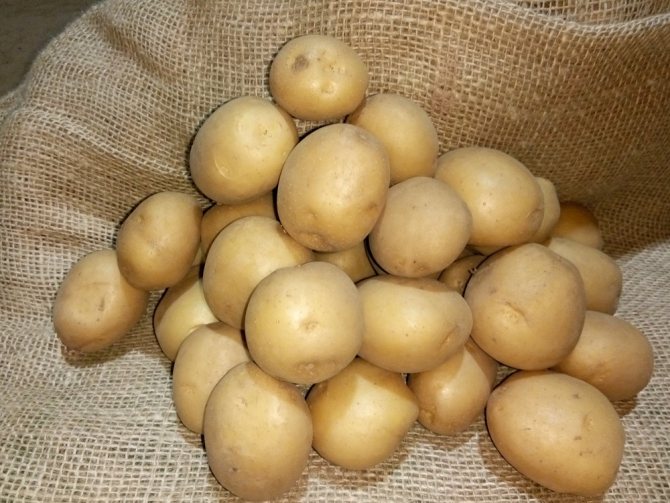

Riviera potatoes: healthy tubers ready to plant
Preparing a site for potatoes
When growing super-early potatoes, you need to adhere to some rules.
- The soil should be sandy loam and light.
- The site is thoroughly cleared of weeds and fertilized since autumn.
- The next planting of potatoes in these beds is allowed no earlier than 3 years later.
- It is necessary to treat the area with insecticides before planting tubers.
Clay soil can be improved by adding compost, humus, and sand. Since autumn, rotted manure is laid out on the site: 45 buckets per hundred square meters and dug deeply.
Another method of fertilization is sowing winter rye, the seedlings of which are embedded in the soil in spring. Before the autumn digging, you can sow white mustard. When the plant reaches a height of about 10 cm, the site is dug up.
To destroy the wireworm, a weak solution of potassium permanganate is used, which is poured over the holes during planting. They scare away pests with onion peels, add a handful to the pits.
If young potatoes are grown for sale, then rows are prepared, placing them from south to north, at a distance of 50 cm. When grown for storage, for planting tubers, 65 - 70 cm is left between the rows. The distance between the bushes is at least 25 cm.

